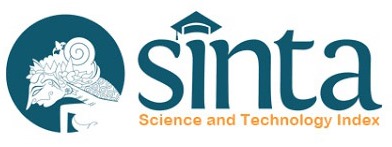Evaluation of Non-Saccharomyces Cerevisiae Strains Isolated from Sea Water Against Inhibitory Compounds for Ethanol Production
Abstract
An important parameter in industrial bioethanol fermentation is the resistance of yeast to osmotic pressure and inhibitor compounds. Aureobasidium pullulans LBF-3-0074 and Schwanniomyces etchellsii LBF-3-0034 are reported capable to produce ethanol. LBF-3-0034 and LBF-3-0074 are yeast strains isolated from Bali and Lombok sea water. This study aimed to evaluate characteristics of both LBF-3-0034 and LBF-3-0074 strains under the effects of glucose and inhibitor compounds. Both strains were allowed to consume glucose up to 120 mM. Then, these strains were grown with the present of several inhibitors, i.e. 5-hydroxymethyl-2-furaldehyde (5-HMF), furfural, acetic acid, formic acid, and levulinic acid. Results showed that the two yeast strains studied could grow and ferment the sugars under both osmotic and inhibitor stress conditions. As conclusion, Schwanniomyces etchellsii LBF-3-0034 and Aureobasidium pullulans LBF-3-0074 are potential for direct fermentation of lignocellulosic hydrolysate to ethanol.
Keywords
Full Text:
PDFReferences
Allen, S.A., Clark, W., McCaffery, J.M., Cai, Z., Lanctot, A., Slininger, P.J., Liu, Z.L., & Gorsich, S.W. (2010). Furfural induces reactive oxygen species accumulation and cellular damage in Saccharomyces cerevisiae. Biotechnology Biofuel, 3, 2.
Barber, A.R., Hansson, H., Pamment, N.B. (2000). Acetaldehyde stimulation of the growth of Saccharomyces cerevisiae in the presence of inhibitors found in lignocellulose to ethanol fermentations. Journal Industrial Microbiology & Biotechnology, 25, 104-108.
Cantarella, M., Cantarella, L., Gallifuoco, A., Spera, A., & Alfani, F. (2004). Effect of inhibitors released during steam-explosion treatment of poplar wood on subsequent enzymatic hydrolysis and SSF. Biotechnol. Prog, 20, 200-206.
Chandel, A.K., Chan, E.C., Rudravaram, R., Narasu, M.L., Rao, L.V., Ravindra, P. (2007). Economics and environmental impact of bioethanol production technologies: an appraisal. Biotechnol Mol Biol Rev, 2,14-32.
da Silva R.O., BatistoteII, M., CeredaIII, M.P. (2013). Alcoholic fermentation by the wild yeasts under thermal, osmotic and ethanol stress. Brazilian Archives of Biology and Technology, 56(2), 161-169. http://dx.doi.org/10.1590/S1516-89132013000200001
Estruch, F. (2000). Stress-controlled transcription factors, stress- induced genes and stress tolerance in budding yeast. Review FEMS Microbiology, 24, 469-486.
Fujita, Y., Takahashi, S., Ueda, M., Tanaka, A., Okada, H., Motikawa, Y. (2002). Direct and efficient production of ethanol from cellulosic material with a strain displaying cellulolytic enzyme. Applied Environmental Microbiology, 68(10), 5135-5141.
Gibson, B.R., Lawrence, S.J., Leclaire, J.P.R, Powell C.D., Smart, K.A. (2007). Yeast responses to stresses associated with industrial brewery handling. FEMS Microbiol Rev, 31, 535-569, DOI: 10.1111/j.1574-6976.2007.00076.x.
Horváth, I.S., Franzén, C.J., Taherzadeh, M.J., Niklasson, C., Lidén, G. (2003). Effects of furfural on the respiratory metabolism of Saccharomyces cerevisiae in glucose-limited chemostats. Applied Environmental Microbiology, 69(7), 4076-4086.
Kathiresan, K., Saravanakumar, K., & Senthilraja, P. (2011). Bioethanol production by marine yeasts strain from coastal mangrove sediment. International Multidiscipline Research, J 1,19-24.
Khambhaty, Y., Upadhyay, D., Kriplani, Y., Joshi, N., Mody, K. & Gandhi, M.R. (2013). Bioethanol from macroalgal biomass: utilization of marine yeast for production of the same. Bioenergy Research, 6, 188-195.
Liu, Z.L., Moon, J., Andersh, A.J., Slininger, P.J., & Weber, S. (2008). Multiple gene mediated NAD(P)H-dependent aldehyde reduction is a mechanism of in situ detoxification of furfural and HMF by ethanologenic yeast Saccharomyces cerevisiae. Applied Microbiololgy Biotechnology, 81, 743-753.
Liu, Z.L., Slininger, P.J., Dien, B.S., Berhow, M.A., Kurtzman, C.P., Gorsich, S.W. (2004). Adaptive response of yeasts to furfural and 5- hydroxymethylfurfural and new chemical evidence for HMF conversion to 2, 5-bis-hydroxymethylfuran. Journal Industrial Microbiology and Biotechnology, 31,345-352.
Martin, C., Marcelo, M., Almazan, O., Jonsson, L.J. (2007). Adaptation of a recombinant xylose-utilizing Saccharomyces cerevisiae strain to a sugarcane bagasse hydrolysate with high content of fermentation inhibitors. Bioresources Technology, 98-1767-1773.
Martosuyono, P., Hakim, A. & Fawzya, Y.N. (2015). Chemical pretreatment and enzymatic saccharification of seaweed solid wastes. Squalen Bulletin of Marine & Fish. Postharvest & Biotech, 10(2), 61-71.
Mills, T.Y., Sandoval, N.R., & Gill, R.T. (2009). Cellulosic hydrolysate toxicity and tolerance mechanisms in Escherichia coli. Biotechnology Biofuel, 2, 26.
Modig, T., Lidén, G., & Taherzadeh, M.J. (2002). Inhibition effects of furfural on alcohol dehydrogenase, aldehyde dehydrogenase and pyruvate dehydrogenase. Biochemical Journal, 363(P3), 769-776.
Moysés, D.N, Reis, V.C.B., de Almeida, J.R.M, de Moraes, L.M.P., & Torres, F.A.G. (2016). Xylose Fermentation by Saccharomyces cerevisiae: Challenges and Prospects. International Journal Molecular Science, 17(3), 207, doi: 10.3390/ijms17030207.
Nguyen, T.H.M., & Hanh, V.V. (2012). Bioethanol production from marine algae biomass: prospect and troubles. Journal of Vietnamese Environment, 3(1), 25-29. DOI (PDF): http://dx.doi.org/10.13141/jve.vol3.no1.pp25-29.g22
Nitiyon, S., Keo-oudone C., Murata, M., Lertwattanasakul, N., Limtong, S., Kosaka, T., & Yamada, M. (2016). Efficient conversion of xylose to ethanol by stress-tolerant Kluyveromyces marxianus BUNL-21, Springerplus, 5, 185. doi: 10.1186/s40064-016-1881-6.
Nutawan, Y., P. Phuriphipat, P., Treyawutthiwat & Eshtiaghi, M.N. (2010). Bioethanol production from rice straw, Energy Research Journal, 1(1), 26-31.
Palmqvist, E., & Hahn-Hagerdal, B. (2000). Fermentation of lignocellulosic hydrolysates. I: Inhibition and detoxification. Bioresources Technology, 74 17-24.
Palmqvist, E., Grage, H., Meinander, N.Q., & Hahn-Hagerdal, B. (1999). Main and interaction effects of acetic acid, fur- fural and hydroxybenzoic acid on growth and ethanol productivity of yeasts. Biotechnology Bioengineering, 63, 46-55. PMID: 10099580
Pensupa, N., Jin, M., Kokolski, M., Archer, D.B., & Du, C. (2013). A solid state fungal fermentation-based strategy for the hydrolysis of wheat straw. Bioresources Technology, 149, 261-267.
Quéméneur, M., Hamelin, J., Barakat, A., Steyer, J.-P., Carrère, H., & Trably, E. (2012). Inhibition of fermentative hydrogen production by lignocellulose-derived compounds in mixed cultures. International Journal of Hydrogen Energy, 37, 3150-3159.
Saravanakumar, K., Senthilraja, P. & Kathiresan, K. (2013). Bioethanol production by mangrove-derived marine yeast Sacchromyces cerevisiae. Journal of King Saud University- Science, 25, 121–127.
Scarlat, N., Dallemand, J.F., Ferrario, F.M., & Nita, V. (2015). The role of biomass and bioenergy in a future bioeconomy: Policies and facts. Environmental Development. 15:3-34.
Senthilraja, P., Kathiresan, K. & Saravanakumar, K. (2011) Comparative analysis of bioethanol production by different strains of immobilized marine yeast. Journal Yeast Fungal Res, 8, 113-116.
Shweta, S., Pandeyb, A., & C.K., Dwivedia. (2016). Bioelectricity production from various feedstocks using pure strain of Bacillus firmus. International Journal Renewable Energy Development, 5(2), 119-127.
Sun, Y., & Cheng, J. (2002). Hydrolysis of lignocellulosic materials for ethanol production: a review. Bioresources Technology, 83, 1-11.
Talebnia, F., & Taherzadeh, M.J. (2006) In situ detoxification and continuous cultivation of dilute-acid hydrolysate to ethanol by encapsulated Saccharomyces cerevisiae. Journal of Biotechnology, 125, 377-384.
Tesfaw, A., & Assefa, F. (2014). Current trends in bioethanol production by Saccharomyces cerevisiae: substrate, inhibitor reduction, growth variables, coculture and immobilization. International Schorlarly Research Notices. 2014. ID 532852, 11 pages. http://dx.doi.org/10.1155/2014/532852.
Van Wyk JPH. (2001). Biotechnology and the utilization of biowaste as a resource for bioproduct development. Trends Biotechnology, 19, 172-177. PMID: 11301129
Walker, G.M. (1998). Yeast. Physiology and Biotechnology. London, UK: John Wiley and Sons Publishers.
Zaky, A.S., Tucker, G.A., Daw, Z.Y., & Du, C. (2014). Marine yeast isolation and industrial application. FEMS Yeast Research, 14, 813-825.
DOI: https://doi.org/10.15578/squalen.284
Refbacks
- There are currently no refbacks.
ISSN : 2089-5690(print), E-ISSN : 2406-9272(online)
This work is licensed under a Creative Commons Attribution-NonCommercial-ShareAlike 4.0 International License.










